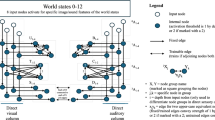Abstract
In an influential and provocative paper, Fodor and Pylyshyn (1988) have argued that the architecture of mind cannot be connectionist ”at the cognitive level”. Very briefly, they maintain that explanation of cognitive capacities requires a domain of complex mental representations with combinatorial syntactic and semantic structure to account for features of cognition like systematicity, compositionality and inferential coherence. Since connectionist models lack these complex representations (while still being committed, as Fodor and Pylyshyn claim, to the concept of representation as such), these models are inadequate for the explanation of cognitive skills. But (so they generously concede) connectionist models might still turn out to be — or be interpreted as — implementations of ”classical” symbol-processing accounts.
Access this chapter
Tax calculation will be finalised at checkout
Purchases are for personal use only
Preview
Unable to display preview. Download preview PDF.
Similar content being viewed by others
References
Bogdan, R.J. (1989): Does semantics run the psyche? Philosophy and Phenomenological Research 49: 687–700.
Clark, A. (1988): Critical notice: Psychosemantics: the problem of meaning in the philosophy of mind (JA. Fodor). Mind 97: 605–617.
Clark, A. (1989): Microcognition: philosophy, cognitive science, and parallel distributed processing. Cambridge, Mass.: MIT Press.
Cummins, R. (1989): Meaning and mental representation. Cambridge, Mass.: MIT Press.
Dennett, D. (1987): Evolution, error, and intentionality. In: Dennett, D.: The intentional stance. Cambridge, Mass.: MIT Press: 287–321.
Dretske, F. (1988): Explaining behavior. Reasons in a world of causes. Cambridge, Mass.: MIT Press.
Fodor, J.A. (1987): Psychosemantics: the problem of meaning in the philosophy of mind. Cambridge, Mass.: MIT Press.
Fodor, J.A., Pylyshyn, Z.W. (1988): Connectionism and cognitive architecture: a critical analysis. Cognition 28: 3–71.
Goschke, Th., Koppelberg, D. (1990a): Connectionism and the semantic content of internal representation. Revue Internationale de Philosophie 172: 87–103.
Goschke, Th., Koppelberg, D. (1990a): Connectionism and the semantic content of internal representation. Revue Internationale de Philosophie 172: 87–103.
Helm, G. (1989): Klassische vs. konnektionistische Modelle in der Kognitiven Psychologie. In: Becker, B. (Hrsg.): Zur Terminologie in der Kognitionsforschung. St. Augustin: GMD: 103–111.
Jackson, F., Pettit, P. (1988): Functionalism and broad content. Mind 97: 381–400.
Kurthen, M. (1990): Das Problem des Bewußtseins in der Kognitionswissenschaft. Stuttgart: Enke.
Lischka, C. (1987): Ober die Blindheit des Wissensingenieurs, die Geworfenheit kognitiver Systeme und anderes. KI 4: 15–19.
McGinn, C. (1989): Mental content. Oxford: Basil Blackwell.
Millikan, R.G. (1984): Language, thought, and other biological categories. Cambridge, Mass.: MIT Press.
Millikan, R.G. (1989): Biosemantics. Journal of Philosophy 86: 281–297.
Rowlands, M. (1989): Discussion of Jackson and Pettit, ‘Functionalism and broad content’. Mind 98: 269–275.
Sellars, W. (1956): Empiricism and the philosophy of mind. In: Feigl, H., Scriven, M. (eds.): Minnesota studies in the philosophy of science, Vol. 1. Minneapolis: University of Minnesota Press: 253–329.
Sellars, W. (1979): Naturalism and ontology. Reseda, Cal.: Ridgeview.
Smolensky, P. (1987): The constituent structure of connectionist mental states: a reply to Fodor and Pylyshyn. The Southern Journal of Philosophy 26: 137–160.
Stich, S. (1983): From folk psychology to cognitive science. Cambridge, Mass.: MIT Press.
Winograd, T., Flores, F.: Understanding computers and cognition. Norwood: Ablex.
Author information
Authors and Affiliations
Editor information
Editors and Affiliations
Rights and permissions
Copyright information
© 1990 Springer-Verlag Berlin Heidelberg
About this paper
Cite this paper
Kurthen, M., Linke, D.B., Hamilton, P. (1990). Connectionist Cognition. In: Dorffner, G. (eds) Konnektionismus in Artificial Intelligence und Kognitionsforschung. Informatik-Fachberichte, vol 252. Springer, Berlin, Heidelberg. https://doi.org/10.1007/978-3-642-76070-9_7
Download citation
DOI: https://doi.org/10.1007/978-3-642-76070-9_7
Publisher Name: Springer, Berlin, Heidelberg
Print ISBN: 978-3-540-53131-9
Online ISBN: 978-3-642-76070-9
eBook Packages: Springer Book Archive




